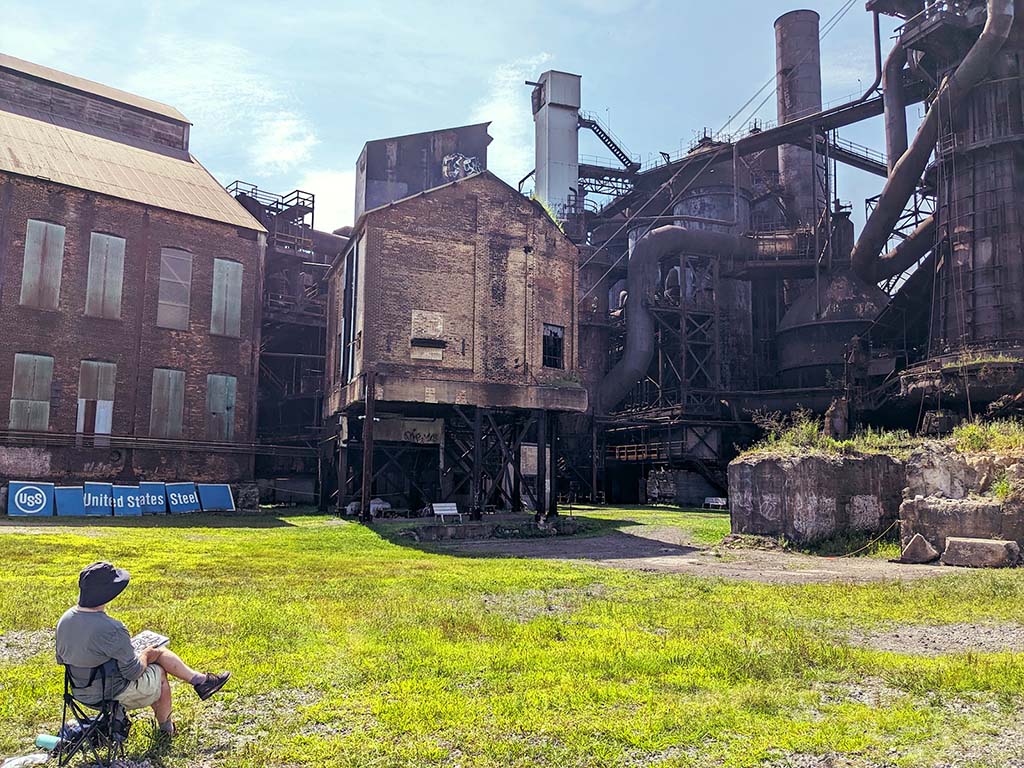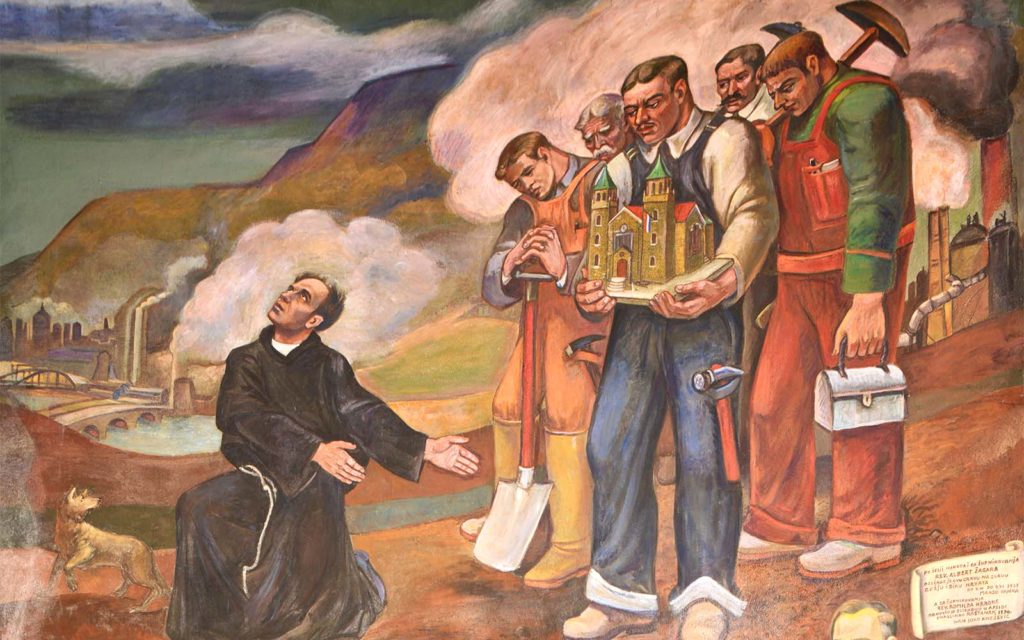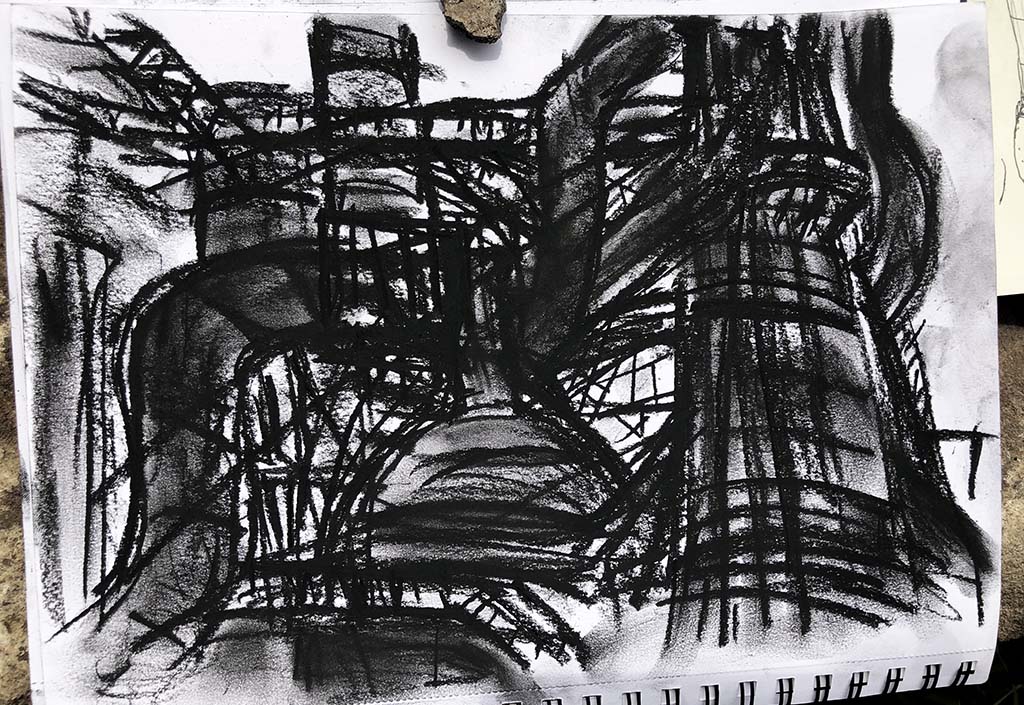
Gledaj! sketching workshops explore Maxo Vanka’s perspective. Photo by Lynne Squilla.
Community Spotlight—Gledaj! Sketching Workshops
The Community Spotlight series features the efforts of Rivers of Steel’s partner organizations, along with collaborative partnerships, that reflect the diversity and vibrancy of the communities within the Rivers of Steel National Heritage Area. Today’s story explores the Gledaj! Sketching Workshops that capture the spirit behind the inspiration Maxo Vanka took from Pittsburgh’s vistas.
By Lynne Squilla, Contributing Writer
Visions of Carrie
On a hot, sunny day in late July 2024, a group of 30 people gathered at the towering Carrie Blast Furnaces National Historic Landmark. Holding sketchbooks, easels, brushes, pencils, and pens, the group listened to some inspiration from local artists then quietly dispersed across the grounds, each looking around intently before settling down to create their own visions of this remarkable site.
This was the second Carrie Furnaces Gledaj! Sketching Session since 2023, conducted by the Society to Preserve the Millvale Murals of Maxo Vanka (SPMMMV). It has become a happy collaboration between the Society and Rivers of Steel, sponsored in part by a Rivers of Steel Mini-Grant. The images these visitors created were diverse and breathtaking, capturing the power, beauty, and spirit of this National Historic Landmark. The experience tied together two of our area’s important industrial heritage sites, raising awareness of these treasures and their impact on the region and the world.

Sketching at Carrie. Photo by Anna Doering.
Croatian-born artist Maximilian “Maxo” Vanka was a classically trained artist who constantly sketched birds, animals, people, situations—and industrial structures. These Gledaj! sketching sessions were inspired by his bold murals emblazoned on the walls of St. Nicholas Croatian Church in Millvale.
“Maxo Vanka loved the grit and muscularity of Pittsburgh,” said Anna Doering, executive director of SPMMMV, pointing out that he first came here in 1935 and drew the dramatic landscape of factories and furnaces, as well as bridges, rivers, and the then newly constructed Cathedral of Learning.
Recruited by St. Nicholas’ priest, Father Albert Zagar, to fill the blank walls of his Croatian-Catholic church on a hill in Millvale, Vanka crafted 25 murals in two great bursts of energy in 1937 and 1941. They are a mix of religious imagery and poignant scenes of life for the Croatian immigrants who came to toil in Pittsburgh’s coal mines, iron furnaces, and steel mills.
“Look at The Immigrant Mother Gives Her Son for Industry, and there are blast furnaces in the background,” Doering reflected, referencing the murals. “Also in The Simple Family Meal. And Injustice: the flames at the feet of that figure [can be compared to] the flames of industry. Behind Father Zagar on the altar mural, you can see smokestacks and downtown Pittsburgh.”

Maxo Vanka’s mural showing Father Zagar, Croatian immigrants, and smokestacks of Pittsburgh. Courtesy of SPMMMV.
“So, tying the murals to Carrie and Rivers of Steel,” she continued, “the synergy is that both organizations are trying to preserve these parts of Pittsburgh’s history: its industry, its past, its workers. We’re telling very similar stories about the immigrant experience.”
The original concept for the sketching sessions came from a meeting between Doering and Pittsburgh-born architect John Martine, who traveled Europe drawing landmarks and landscapes. He also has a prestigious solo art career, along with connections to historical and preservation organizations. Martine remains involved in the sketching sessions that have featured other Pittsburgh sites and neighborhoods, with guidance from other local painters, architects, graffiti and mural artists, and educators.
Rick Landesberg, founder of Landesberg Design and retired faculty at Carnegie Mellon University’s School of Design, led the Carrie sketching session in 2023, and in 2024 he was joined by designer, artist, and CMU professor, Laura Vinchesi.

Rick Landesberg at the Carrie Blast Furnaces. Photo courtesy of Rick Landesberg.
“I have always kept a sketchbook,” says Landesberg. “It is an observational tool that helps you look. So, even if you only draw moderately well, it forces you to look carefully at things. The energy of observing goes to the page. How often do you really look at something for six minutes? You sure do when you’re drawing. You own it!”
This concept of intense observation closely parallels Vanka’s approach. His mantra was the Croatian word Gledaj!, which translates to Look! See! The term became the theme for SPMMMV’s sketching sessions, as well as the title of a past collaboration with Rivers of Steel at its Bost Building in 2023: Gledaj! The Gaze of Maxo Vanka. More than 130 of Vanka’s early drawings and preparatory sketches for the murals were on display.
In particular, Vanka’s views of Pittsburgh’s rivers, bridges, and industry seemed appropriately placed in the Bost Building, which received National Historic Landmark recognition for its role in the1892 labor lockout and strike most commonly referred to as the Battle of Homestead.
Landesberg was impressed by how the Carrie sketch participants, who had a range of skill levels, took Vanka’s Gledaj! message to heart, keenly studying the sights before drawing them.
For Shaun Slifer, a multidisciplinary artist, founder of Justseeds Artists’ Cooperative, and creative director for the West Virginia Mine Wars Museum, it was his first visit to Carrie, though he had been aware of it and had visited the Vanka murals multiple times.
“I was doing a lot of Gledaj-ing,” he laughed. “It was a great way to spend a Sunday. I had no idea what any of the structures were for, not having grown up here with the mills. I drew this high-up room with corrugated walls, like a tree house. It did make me want to take a tour of the site to learn more!”

A sketch by Sue Mals. Photo courtesy of Sue Mals.
Two-time sketching session participant and retired engineer Sue Mals added, “The more you quiet your mind, the more you see. While sketching, I did think about all of the many feet that trod before where I was seated to do my sketching. It was an interesting dichotomy that it was rather quiet with just some bird song in the air while I was sketching, whereas when the Carrie Blast Furnaces were operational, a loud cacophony of sounds would have been in the air.”
What emerged from the four-hour sessions were bold charcoal portraits of the furnaces, fine-lined ink pen renditions, soft watercolors and pastel visions, playful crayon depictions, and simple felt marker silhouettes. Some of the representations were even reminiscent of Vanka’s sketching technique.
“The styles that came out of it were quite broad,” noted Landesberg. “I was surprised at how many brought watercolors and brushes. Some folks really stretched their medium. The work of one artist—Gideon Kossoff’s charcoal drawings—were really loose, really active. He went at it with great energy, though he is, in person, a really soft-spoken guy.” Many of the participants focused on the behemoth Furnaces #6 and #7, while others like Slifer zeroed in on some small detail of a gear or bolt or tree nestled within the massive structures. In 2023, one of the artists even placed paper on the surface of one of the edifices and made a textured rubbing.

A sketch by Shaun Slifer. Photo courtesy of Shaun Slifer.
“I got interested in seeing the plants growing up through the slag and rust. I drew a crumbling wall,” Slifer explained. “The place was eerie but wonderful.”
Charles Lucas had worked in U.S. Steel’s Open Hearth #4 as a college student and currently takes commissions to paint religious icons. It was his second session at Carrie, and he felt a connection between the industrial remnants and Vanka’s images of workers: “There’s the image of the fallen worker and the women weeping for him. That’s the worker—the ‘grunt’—that’s who some would say worked at Carrie. But they weren’t. Those guys were amazing and knew how to do their jobs.”
“Carrie is a strange and magical place,” Landesberg said. “It’s peaceful now, like a cemetery, but a violent place when it was active. It has a drama to it, though now sitting still and silent. And just in sheer physical, graphic terms, it is an amazing place.”

A charcoal image of furnace #7 and the gas washer sketched by Gideon Kossoff. Photo by Lynne Squilla.
Just as Rivers of Steel has done with the Carrie Blast Furnaces, the Bost Building, and the Pump House, SPMMMV works to preserve the Vanka murals and their stories inside St. Nicholas Croatian Church in Millvale by constantly devising innovative programming that appeals to an ever-broadening audience. The partnership with Rivers of Steel has allowed both organizations to reach visitors who might not otherwise know about these sites or the Pittsburgh history and universal lessons they represent.
“With Gledaj! helped by the Mini-Grants, SPMMMV can launch new programs and ideas, test them out as outreach, which helps us to establish an idea and make it sustaining or find new support for these efforts,” Doering explained. “We can also reach out to other organizations, and having this matching component is always vital to show donors new reasons to give.”
Doering was pleased by how much the groups enjoyed the sessions in 2023 and 2024. “People loved getting out to places they’d previously never been to, getting together with new people with similar interests, and engaging around the Vanka murals’ stories. These timeless stories are a gift to every generation, connecting us to shared history and lived experiences that influence our region and our country today. Unique sites like these make Pittsburgh a one-of-a-kind destination.”
Slifer put it more simply: “I just thought it’s great that two organizations that I think are cool are doing something together!”
Carrie was just one location for SPMMMV’s Gledaj! Sketching Sessions. Since 2023, the program also brought groups to Pittsburgh’s South Side and Polish Hill neighborhoods, as well as Allegheny Cemetery. On September 8 there will be a session at Allegheny Commons in the North Side, and on October 6 inside St. Nicholas Croatian Church and Millvale environs to sketch from the murals themselves, along with the surrounding postindustrial neighborhood. For more information or to reserve a space in the sketching group, visit https://vankamurals.org/events-activities/sketching-sessions/.
About the Mini Grant Program
Rivers of Steel’s Mini-Grant Program assists heritage-related sites and organizations as well as municipalities within the Rivers of Steel National Heritage Area to develop new and innovative programs, partnerships, exhibits, tours, and other initiatives. Funded projects support heritage tourism, enhance preservation efforts, involve the stewardship of natural resources, encourage outdoor recreation, and include collaborative partnerships. Through these efforts, Rivers of Steel seeks to identify, conserve, promote, and interpret the industrial and cultural heritage that defines southwestern Pennsylvania.
The Rivers of Steel National Heritage Area is one of twelve supported by the Pennsylvania Department of Conservation and Natural Resources (DCNR). Funding is provided via DCNR’s Community Conservation Partnerships Program and the Environmental Stewardship Fund to Rivers of Steel, which administers the Mini-Grant Program.

Lynne Squilla is a skilled and creative storyteller. She honed her craft as a writer and producer / director of original scripts, documentaries, articles, web content, stage, and other live presentations. While her work has taken her across the globe, she’s rooted in the Mt. Washington neighborhood of Pittsburgh, and has a passion for sharing stories about our region’s past.
Check out Lynne’s previous article on Rivers of Steel’s new workforce development program.







